Pros
Cons
Introduction
Although the Shure SE530s are at the top of the line, they aren't all that different from the next model down, the SE420s. While the SE530s come with a few more extras, they have an equivalent sound quality.
The Shure SE530s are currently available for about $300.
Product Overview
{{section_header}}{{section.name}}{{/section_header}}
The Shure SE530s are a set of modular in-ear headphones, meaning their cord is super short.
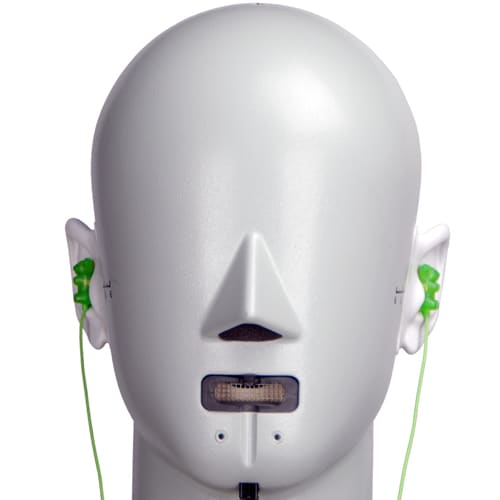
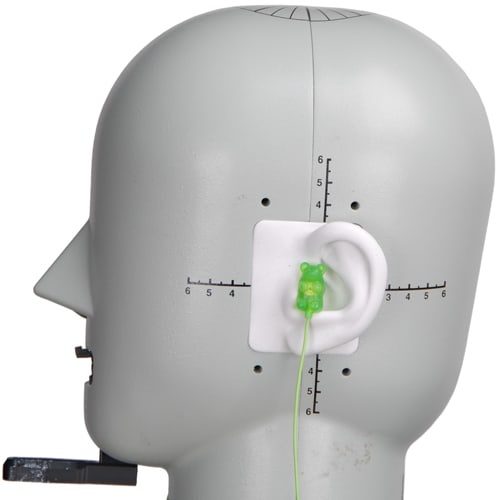
Speakers
{{section_header}}{{section.name}}{{/section_header}}
The ear buds themselves have a somewhat interesting design: the nozzles stick out at an angle. The headphones naturally sit with the cord facing up and the nozzles pointing in towards your ear. This is great for those that like wrapping the cord around the backs of their ears, but is ever-so-slightly awkward for those that don't.
Sides
{{section_header}}{{section.name}}{{/section_header}}
Back
{{section_header}}{{section.name}}{{/section_header}}
Band
{{section_header}}{{section.name}}{{/section_header}}
Cable
{{section_header}}{{section.name}}{{/section_header}}
The plug-end of the headphones is like a tank. Shure has some of the best cord guards out of any in-ear headphones, which will increase the longevity of your set.
Additional Features
{{section_header}}{{section.name}}{{/section_header}}
In the Box
{{section_header}}{{section.name}}{{/section_header}}
There are a ton of things in the SE530s' box. The headphones come with a volume adapter, an optional remote & mic, an extension cord, a shorter extension cord, a cleaning tool, a total of eight different sleeves of various sizes and styles, a case, and the headphones themselves.
Durability
{{section_header}}{{section.name}}{{/section_header}}
Shure typically makes durable in-ears and the SE530s are no exception. We just have the same two qualms we usually do, and both deal with their nozzle. Typically in-ears top off their nozzles with mesh to prevent garbage from getting into the headphones. The SE530s' mesh wall is set very far back, which leave the majority of the nozzle open to fill up with all kinds of grossness. While the SE530s do come with a cleaning tool, it doesn't reach all the way back to the mesh guard: if something falls all the way to the bottom of the nozzle, it'll sit just out of reach. The second nozzle-related issue is its design itself. The 'bent nozzle' shape seems a bit fragile, like you could snap the headphones if you stepped on them the wrong way. Of course, the easy solution to this is to not run in place on your headphones while wearing metal shoes. Chances are you don't even own a pair of metal shoes, in which case this scenario is even easier to avoid.
All other areas are solid. The ear buds trail off into a rubbery cord guard to keep the cable from bending too sharply at that junction. The cord guard at the plug is so reinforced it looks somewhat comical. The cable's casing is more solid than average. The ear buds are almost difficult to pull off (the foam ones, at least), so there's no real risk in them popping off and getting lost forever.
Like it's predecessors, the Shure SE530s set a standard for in-ear durability.
Aesthetics
{{section_header}}{{section.name}}{{/section_header}}
Aesthetics almost don't apply to in-ears. Since in-ear headphones are so small, it's very difficult to create a great-looking design. Further, also due to their small size, any design flair is likely to go unnoticed. The SE530s' bent nozzle allows users to wear them normally or loop the cord around the back of their ears easily. In terms of their looks, however, they're a bit plain. They're a glossy gray with some white branding on them. If you prefer professional (boring) headphones, the SE530s are a good pick. Otherwise, look for a set of in-ears that at least have a splash of color.
Frequency Response
{{section_header}}{{section.name}}{{/section_header}}
The SE530s had an average frequency response. The main problem we saw with then was that they sort of cut off some of the higher frequencies. As you can see, both the left an right channels dip below the limits towards the high end. This means that spoken sibilance will sound slightly muted, among other things.
While this is an issue, the rest of the curve is great. The bass is slightly emphasized, but not overpowering, and the rest of the response is more or less even.

Click here for more information on our frequency response test.
Distortion
{{section_header}}{{section.name}}{{/section_header}}
The Shure SE530 didn't show a lot of distortion, but it did have some. In general, low, even levels of distortion aren't particularly noticeable. The average consumer should have no issues with the SE530s performance.
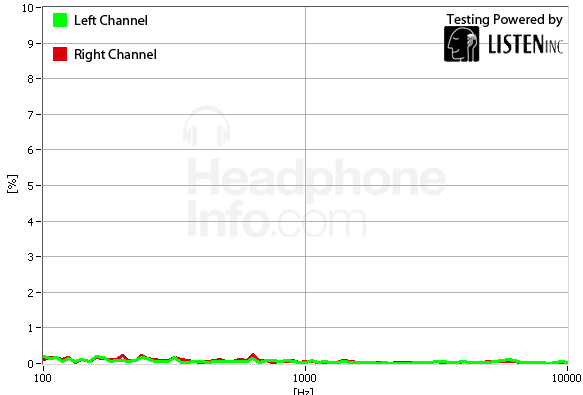
Click here for more information on our frequency response test.
Tracking
{{section_header}}{{section.name}}{{/section_header}}
There really isn't a lot to say here. This line is just about as straight as you can get. The Shure SE530s have near-perfect tracking.
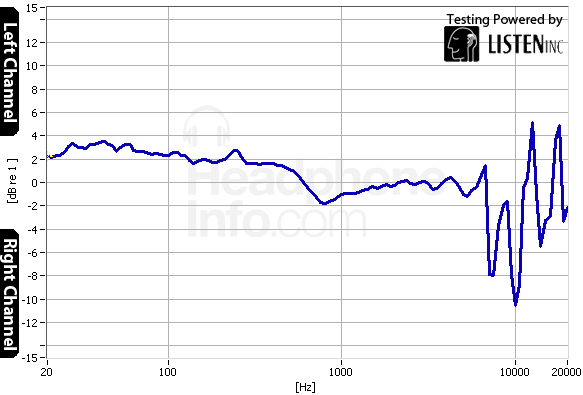
Click here for more information on our frequency response test.
Isolation
{{section_header}}{{section.name}}{{/section_header}}
Like any good set of in-ears, the SE530s do a good job isolating their user from external noise. Also like other in-ears, the SE530s do a much better job blocking out the higher-end part of the spectrum as opposed to the lower.
The SE530s are definitely above average for a set of in-ears, thanks in part to their foam sleeves. These sleeves are essentially a pair of ear plugs, so it isn't surprising they resulted in such a good score.

Click here for more information on our isolation test.
Leakage
{{section_header}}{{section.name}}{{/section_header}}
Most in-ears are great at leakage control, and the SE530s are no exception. Unless you're playing your music at an ungodly loud level no one will be the wiser. Even at higher decibel levels, the most anyone would hear is a whisper.
Click here for more information on our leakage test.
Maximum Usable Volume
{{section_header}}{{section.name}}{{/section_header}}
The SE530s are capable of a harmfully high 127.87 decibel levels. We have a cut-off at 10 points for 120dB for this section, because any louder is just likely to hurt your hearing. We wouldn't recommend trying to max out your volume (unless you want to wind up in the news espousing the evils of iPods).
Click here for more on our maximum usable volume test
Short-Term Use
{{section_header}}{{section.name}}{{/section_header}}
For this section and the next one, be forewarned: our scores and write-up are just based on a few people around our office trying the headphones on for a bit. Even though there are multiple heads involved, chances are yours is different. We therefore recommend trying on all headphones for a few hours before you decide to keep them.
It's been quite some time since we last reviewed a pair of Shure headphones, and our opinions are largely unchanged. Since we don't like looping the cord around the backs of our ears, we're don't find the Shure SE530s to be particularly comfortable. Sure, you can reverse teh left and right channels and they'll fit fine, but that's somewhat annoying, especially if your playback has channel-specific sections. Of course, the degree to which this is annoying will be entirely subjective.
Our issues with the sleeves is about the same as we found with the SE420s. If you use the foam sleeves, the insides of your ears will feel a bit hot and itchy. If you use the other sleeves, they'll tend to get more and more uncomfortable over time.
Regardless, the headphones do stay in pretty well. This, coupled with the short cord, make them good workout headphones.

Extended Use
{{section_header}}{{section.name}}{{/section_header}}
The small decrease in points predominantly comes from the comfort issues above exacerbating over the six hours of wear we use in this test. While the foam sleeves are the most comfortable, they are still a bit warm and scratchy. The other sleeves are a bit too stiff and create a bit of pressure over time. Still, the headphones aren't grossly uncomfortable: for this score, we try to keep 5 as a dead average result. They are definitely not the most comfortable in-ears we've worn, but they're not horrible either.
Customizability
{{section_header}}{{section.name}}{{/section_header}}
Shure headphones tend to come with the most customizability options, and the Shure SE530s are no exception. They come with three different types of sleeves, two of which have varying size options.
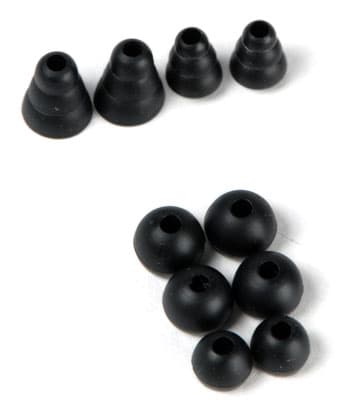
There are two extension cables, one short, one long.

The headphones also come with accessories that add significant value: a volume switch and a remote/mic.

Last, and likely least, the SE530s come with a shirt clip you probably won't use.


Cable Connectivity
{{section_header}}{{section.name}}{{/section_header}}
You can do some silly things with the SE530s in terms of cable connectivity. If you attach all the adapters and extension cables, the SE530s can stretch up to about 8 feet, 8 inches; without any adapters/extensions, the headphones are about 1 foot, 5 inches long. The former number is a bit unrealistic, because that many plug/jack junctions in the cable means it can barely hold its own weight without one of them separating. The latter number is because you're technically supposed to use an extension cord with the headphones in order to reach their actual length, 4 feet, 6 inches. If you want to be fancy and impress your friends with your audiophilia, you can refer to the SE530s' cable as 'modular.'

These are the two cords that come in the box. It would've been nice to have a male-to-male connector to form one long cord, but alas, we do not live in such a world.
The headphones also come with two adapters: a 1/4-inch plug and an airplane plug adapter.
Portability
{{section_header}}{{section.name}}{{/section_header}}
Since the headphones are really just about a foot and a half long, they're incredibly portable. If you're using the cable, however, the cord will be a bit longer than the typical human will need, thus hurting their portability somewhat. Overall, however, it's hard to get more portable than the SE530s, unless you sacrifice durability by having thinner cord casing.
The SE530s come with a case for keeping all your stuff in check, but it doesn't really add to portability. It also isn't the best case for managing your sleeves since it's doesn't have any pockets or anything. We recommend saving the plastic bag the sleeves come in, in order to prevent them exploding everywhere every time you open the case.
Maintenance
{{section_header}}{{section.name}}{{/section_header}}
Typically in-ears just get points for having removable sleeves. The SE530s have them, but they also have a cleaning tool. It isn't anything amazing, just a plastic stick with a wire loop at its end.
Other Features
{{section_header}}{{section.name}}{{/section_header}}
Battery
The SE530s, like many in-ears, do not require batteries. Sure, batteries sometimes power awesome features, like active noise cancellation or wireless connectivity, but their upkeep is annoying. Either you need to replace the batteries or recharge them every so often. Even if they can hold a charge for 36 hours, chances are you'll wind up with headphones that don't function since you're forgetful. The SE530s pick up some points here.
Remote & Mic
This is a much more significant adapter than the above option. Snap this add-on somewhere on your chain of adapters and extensions, and the headphones gain the ability to handle calls or issue your media player basic commands. Be careful: once you get used to a remote and mic, it's hard to go back to not using one.
Volume Control
The SE530s come with an adapter that allows you to adjust their playback volume. While this isn't the most significant feature we've encountered, it is a nice option.
Design
{{section_header}}{{section.name}}{{/section_header}}
Both designs are pretty bland. The SE530s have an interesting shape, but that shape has the potential to make the headphones less comfortable for you. The SE530s are a lot sturdier than the Sennheiser MM 50 iPs, however.
Frequency Response
{{section_header}}{{section.name}}{{/section_header}}
The MM 50 iPs have better bass response, but a slightly more choppy frequency response overall. Regardless, the MM 50 iPs have a better result here.
Distortion
{{section_header}}{{section.name}}{{/section_header}}
Sennheiser headphones are typically devoid of distortion. Since both headphones have less than 1% distortion, however, they both fall under the category of 'ridiculously low distortion.'
Tracking
{{section_header}}{{section.name}}{{/section_header}}
An even, flat response beats on both sides, but the SE530s' is flatter. There's probably no difference between these two to the average listener.
Isolation
{{section_header}}{{section.name}}{{/section_header}}
The SE530s can isolate better than the MM 50 iPs pretty much across the entire board. There's a small chunk at 1kHz that the SE530s didn't feel like blocking out.
Comfort
{{section_header}}{{section.name}}{{/section_header}}
As we're likely to say throughout these comparisons, although the SE530s weren't the most comfortable headphones we've tried on, they do come with far more customizability options than the average set of in-ears. This means that, although we personally didn't think they were as comfortable as other in-ears, they have the potential to give more people a better fit.
Verdict
{{section_header}}{{section.name}}{{/section_header}}
The MM 50 iPs are great headphones with a great price. It's hard to beat them in terms of value. What's more, the SE530s actually didn't best them in terms of audio quality. If you have a strong desire to pick up the SE530s, be it for their fit or for their extras, be our guest; for the majority of buyers, however, the MM 50 iPs would probably be the better choice.
Design
{{section_header}}{{section.name}}{{/section_header}}
The SE530s and SE420s are essentially the same in terms of design. The SE420s go for a straight gray color palette while the SE530s use a bronze motif. Other than this minor change, both sets of headphones are essentially the same.
Frequency Response
{{section_header}}{{section.name}}{{/section_header}}
Interestingly enough, they both have incredibly similar frequency responses as well. The SE530s had a slightly better bass response and a slightly weaker one for mid-range frequencies.
Distortion
{{section_header}}{{section.name}}{{/section_header}}
The SE530s have slightly less distortion than the SE420s, but the difference would likely be hard to hear.
Tracking
{{section_header}}{{section.name}}{{/section_header}}
The SE530s did much better on our tracking test than the SE420s.
Isolation
{{section_header}}{{section.name}}{{/section_header}}
We thought this was strange. The SE420s had a significantly better isolation result than the SE530s. This could be due to many different factors, such as small differences in the compositions of the foam sleeves, or a slightly different positioning.
Comfort
{{section_header}}{{section.name}}{{/section_header}}
Both headphones feel about the same in terms of comfort. They both have very, very similar designs and all the same sleeve options.
Verdict
{{section_header}}{{section.name}}{{/section_header}}
The SE530s are basically the same headphones as the SE420s, but come with better extras. We would probably recommend the SE420s over the SE530s because of their improved isolation. The SE530s' remote and mic adapter is really useful, however.
Design
{{section_header}}{{section.name}}{{/section_header}}
The Vibe Duos have a slightly more appealing look, but aren't as durable. The newer Vibe Duos have a much sturdier plug, but there still aren't cord guards around the control pendant or the ear buds. If you're looking for something with an iota of pizazz, you can't get more pizazzy than a color scheme called 'GunmetalRouge.' If you want a rugged design, the SE530s are a better pick.
Frequency Response
{{section_header}}{{section.name}}{{/section_header}}
The Vibe Duos go a bit zany with the bass, and have a slightly more dynamic (read: choppy) response than we typically like to see.
Distortion
{{section_header}}{{section.name}}{{/section_header}}
The SE530s definitely have a lower overall distortion. It's not by a gigantic amount, but it's there.
Tracking
{{section_header}}{{section.name}}{{/section_header}}
The Vibe Duos are either really difficult to get positioned correctly or they have bad tracking. Either way, the Shure SE530s have them beat.
Isolation
{{section_header}}{{section.name}}{{/section_header}}
The SE530s block out more bass than the Vibe Duos, but not as much high-end noise. Overall, however, the Vibe Duos block out less noise than the SE530s.
Comfort
{{section_header}}{{section.name}}{{/section_header}}
While we thought the Vibe Duos were more comfortable overall, the SE530s come with many more options for customization. It's therefore more likely that the SE530s will be able to provide you with a comfortable fit.
Verdict
{{section_header}}{{section.name}}{{/section_header}}
This match-up will likely come down to how much cash you're willing to spend on a better product. The SE530s have better sound quality (unless you're a sucker for really, really loud bass), come with more extras, and are likely to live a lot longer. The Vibe Duos, on the other hand, cost a few hundred dollars less.
Design
{{section_header}}{{section.name}}{{/section_header}}
We're not sure if anyone is still enamored with Apple's aesthetic, given it's been around for so long, but they do look clean and modern. While the Apple headphones have an advantage on style, they aren't nearly as sturdy as the SE530s.
Frequency Response
{{section_header}}{{section.name}}{{/section_header}}
The SE530s had a better frequency response overall, since they don't have that downward spike towards 10kHz. It's also much more even overall.
Distortion
{{section_header}}{{section.name}}{{/section_header}}
The Shure SE530s are a better pick in terms of distortion because they barely have any. The Apple headphones showed a bit of noise towards the high-end.
Tracking
{{section_header}}{{section.name}}{{/section_header}}
The Apple headphones have a ridiculously flat tracking, but so do the SE530s. Both are just about perfect.
Isolation
{{section_header}}{{section.name}}{{/section_header}}
The SE530s have a much better isolation. All those spots where the Apple In-ears' graph drops downwards are covered by the SE530s.
Comfort
{{section_header}}{{section.name}}{{/section_header}}
The SE530s are more comfortable overall because they actually stay in your ears. If you're moving around, the Apple In-ears will pull loose.
Verdict
{{section_header}}{{section.name}}{{/section_header}}
This is another budget vs. better match-up. Where the price is hundreds of dollars different, it's really up to the consumer to determine whether or not they're willing to make the additional investment. All we will say is that the Apple In-ears are sub-par while the Shure SE530s are above average.
Conclusion
{{section_header}}{{section.name}}{{/section_header}}
The SE530s are a good, if pricey, set of in-ears. They come with the most boxed-in extras we've seen to date, and have solid audio quality across the board. The headphones are also great for those whose headphones always seem to break.
The headphones have two unique factors that aren't for everyone, however. The first is their design: wear these around for a bit before you decide to keep them. The second is their modular cord. While it's definitely a boon to be able to swap in various in-line accessories, it just increases the number of connections that can get pulled apart.
If you're looking for a budget option, the SE530s aren't for you. In the $100, we always recommend the Sennheiser MM 50 iPs. Below that, the new Apple in-ear headphones are a good, if somewhat fragile bet, as are the Denon AH-C351s.
Interestingly enough, the SE530s' biggest competition are the SE420s. They offer comparable audio quality, come with a few less extras, and cost $100 less.
Meet the tester
Mark Brezinski works on the Home Team, reviewing refrigerators, minifridges, dishwashers, washing machines, dryers, air conditioners, air purifiers, and fans.
Checking our work.
Our team is here to help you buy the best stuff and love what you own. Our writers, editors, and experts obsess over the products we cover to make sure you're confident and satisfied. Have a different opinion about something we recommend? Email us and we'll compare notes.
Shoot us an email